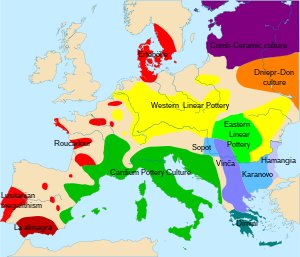Dimini

The late Neolithic settlement and discovery site Dimini gave the Dimini culture its name, which lasted from 4300 to 3300 BC. Existed. The place is about five kilometers southwest of Volos in Thessaly , Greece . The archaeological excavation site got its name from what is now the nearby village of Dimini. The Neolithic settlement is well structured and the pottery found there , often also colored pottery , also gives its name to the late Neolithic period (Dimini culture, 4th millennium BC ) in Greece, which follows the Sesklo culture.
Neolithic dwelling place
About five kilometers west of Volos, the only 16 meter high castle hill of Dimini rises above the Neolithic lower town at the foot of the hill. Just like the older Sesklo, the “princely seat” dates from the 4th millennium BC. BC for the later development of fortified settlements in the Greek cultural area was of decisive importance. Several circular walls that run around the hill are characteristic of the settlement area . The main castle was girded by a ring-shaped lower castle. Longhouses stood here, but also pottery workshops. Several entrances to the center of the complex on the hilltop have been left out in the walls. The main entrance was from the southeast and was in the axis of the manor house. The courtyard had a size of approx. 25 x approx. 32.5 meters and was built on with smaller buildings and a larger, northwest-southeast oriented megaron-shaped house. The house serving the prince (6.0 × 12.0 meters = 20 × 40 feet) was presumably determined quite haphazardly in the natural ground plan by pacing the room sizes. The hall, supported by two round timbers, could be entered from the courtyard through a portico supported by two supports . Behind the hall there was another room, thus the same, but less carefully planned, longhouse type as in Sesklo. The castles of Sesklo and the younger Dimini, which are related in plan, already show the basic scheme of a feudal manor castle, as was common in Mycenae.
The houses of the Neolithic village were not only located on the hill , but were also scattered around it. The Dimini culture already knew the beginnings of metallurgy ( Chalcolithic ), so there were indications for the use of copper and gold . The first city-like fortifications date from this time.
Mycenaean period
On the other hand, a cupola tomb dates from the Mycenaean period, dating from the second half of the 13th century BC. Chr. Dated. The tomb was built into the hill. Remains of a settlement from Mycenaean times were also found, including a larger building complex, which shows that this settlement could not have been insignificant. This is also indicated by imports such as Canaanite amphorae . Although a few fragments of Linear B tablets also emerged, due to the lack of Mycenaean frescoes and a throne room in research, it is doubtful that it is a Mycenaean palace similar to that in Mycenae , Tiryns or Pylos . The complex was destroyed at the end of the Late Helladic III B (around 1200 BC); a resettlement is still for the 12th century BC. Proven.

See also
literature
- Brinna Otto : The decorated ceramics of the Sesklo and diminiculture of Thessaly (= ceramic research. Vol. 6). von Zabern, Mainz 1985, ISBN 3-8053-0776-4 (at the same time: Innsbruck, University, habilitation paper, 1982).
Web links
- Panorama view by Dimini (English, Quicktime required)
Individual evidence
- ^ Jeremy B. Rutter & Dartmouth College, Aegean Prehistoric Archeology. Lesson 2: Narrative The Neolithic Cultures of Thessaly, Crete, and the Cyclades.
- ↑ Epochs of the political and cultural development of Greece's history: The early history, the "dark" and the geometrical time. Last update: November 9th, 2012
- ↑ Introduction to the Study of Classical Archeology I: Introduction to Greek Archeology. Winter semester 2007/08, Graz University Library
- ↑ Heide Göttner-Abendroth: Society in Balance: Gender Equality Consensus Culture in matrilineal, matrifocal, matriarchal societies: Documentation of the 1st World Congress for Matriarchy Research 2003 in Luxembourg. W. Kohlhammer Verlag, Stuttgart 2006, ISBN 3-17-018603-5 , p. 196
- ↑ Ioannis Aslanis: The late Neolithic and the beginning Chalcolithic in West Macedonia, Greece. In: B. Hansel, E. Studenicova (ed.): Between the Carpathians and the Aegean, commemorative book for V. Nemejsova-Pavukova. Studia Honorica 21, 2004, 39-46
- ↑ Brief overview of the finds from the Mycenaean period with Birgitta Eder : Reflections on the political geography of the Mycenaean world, or: Arguments for the supra-regional importance of Mycenae in the Late Bronze Age Aegean. In: Geographia Antiqua. XVIII, 2009, p. 23f. (with further evidence)
Coordinates: 39 ° 21 ′ 43 " N , 22 ° 53 ′ 36" E